Imagine someone handing you a list of the next nine things to do to propel your business, department, or startup to success.
How valuable would that list be to you?
Done properly, a SWOT analysis will give you just such a list. A thorough SWOT analysis will show you what to fix on the inside, what to guard against on the outside, and how to exploit your strengths and the competition's weaknesses.
In case you haven't heard of a SWOT analysis, let's start with a simple explanation and what makes a SWOT analysis important for strategic planning.
What is a SWOT Analysis Chart?
A SWOT analysis is a tool for business planning. SWOT template use brings out the four key areas of your business, decision, or strategy development to focus on and help you decide the next step.
Here they are:
- Strengths. These are your internal strong points or the things that your company does better than any competitors. Examples could include your team, intellectual property, technologies, resources, and location.
- Weaknesses. List the weak points of your company or organization that your competitors do better than you. Some internal factors could include having a high employee turnover rate, limited resources, or a lack of expertise in a particular area.
- Opportunities. These are the external things you can capitalize on. Opportunities would include rising demand for your product or a lack of competition in the area.
- Threats. List the things outside your company that could cause problems. A rise in the cost of materials would be a major threat. And while you don't have any control over your threats, it's good to know about these obstacles in order to form plans to combat them.
We'll unpack all four as we go along. The key part of using a SWOT analysis template for your business is to take a well-rounded view of every aspect of your organization.
Let's get into each of these areas in more detail.
How Can You Use the Parts of SWOT Analysis Templates?
SWOT diagrams are split into four sections, but there are really two main divisions:
- Internal analysis of your strengths and weaknesses.
- External analysis of opportunities and threats facing your organization.
These can blend together, but we'll show you how to make the most of each part of the SWOT matrix.
Judge Your Internal Capabilities with the Strengths and Weaknesses Sections
Start your SWOT analysis with your own business. Your marketing team will know your products, staff, strengths and weaknesses, and your growth history.
Here are some ways to get the most out of the "Strengths and Weaknesses" section:
- Give your team specific metrics to measure your growth. You can use a template form for your team members or simply ask them open questions.
- Discover your strengths by examining the areas where your growth exceeds your metrics. For example, if your lead success rate is superb, then your sales team is a strength. Dig into this a little more to be more specific about your specific strength.
- Unearth your weaknesses by doing the opposite. When one of your metrics isn't being met, question why. Ask your team probing questions and be open to every answer.
Vagueness is the enemy of every SWOT analysis. When you're asking questions and digging into your metrics, try to avoid vague answers.
What are vague answers? Here are some ideas of vague SWOT analyses:
- "We've established and managed a strong capital base."
- "Establishing a reputation on the internet will be challenging."
- "High quality of products and services."
What's missing from these statements?
They lack context and real data. Let's have a look at the last one:
"High quality of products and services."
How do you know you have high-quality products and services? Where do you go from there? More specific data could include:
- Number of positive product reviews.
- Quotes from actual product reviews highlighting features that customers like.
- Location of product reviews, such as review websites, your own website, or social media.
With these extra answers, your strength becomes something you can use for a follow-up action plan.
The end goal of your SWOT analysis is to produce action and positive change. Without specific data and clear analysis, your SWOT matrix will not have the depth necessary to produce any meaningful change for your business.
Analyze Your Competition with the Opportunities and Threats Sections
The external opportunities and threats area of the SWOT diagram is where you examine your competitors, external factors, and perform a market analysis. Data is just as important in this section of the SWOT analysis template. Without real data, you risk viewing your competitors through the lens of your own perceptions rather than reality.
So how do you avoid the risk of a half-baked SWOT analysis of the external factors facing your business?
Here are some ways to avoid a shallow analysis:
- Can you gather enough data to measure your competitors with the same metrics you use internally? If so, these are the numbers you should use to start your SWOT analysis of threats. Threats from your competition include higher sales rates, larger profit margins, and better product reviews.
- When you consider opportunities, the key is to start as broad as possible. Spend time with your team thinking and creating a long list of opportunities. Growth is not possible without progress and ideas. So start your analysis with a huge list of ideas.
The opportunities and threats facing your business are many. During the analysis, your team should remain as open as possible to new innovative ideas and different ways of thinking about your competitors. During the SWOT analysis process, your competitors are actually your teachers.
How to Use Your SWOT Analysis Results to Make Business Decisions and Strategy
The end goal of every SWOT analysis should be action, change, and progress. If this isn't the case, then a SWOT analysis is simply a waste of time.
So, how do you transform the analysis into action?
Your SWOT Diagram Shows You Areas for Growth
Let's start with something simple:
Dead things don't grow.
So don't start your quest for the next step in the external section of your SWOT analysis. Your company isn't 'alive' there. Start in the internal section where you have life as a company.
Examine your strengths as items you can exploit further. For example:
- Could your high-converting website bring in even more business if you ran targeted ads?
- Your blog has a large subscriber base and a long email list. Could this be a marketing project?
Each item you add as a strength can become a product, project, or process you can use to take another step forward in the market.
What about your weaknesses? These areas have life in your business, but they are struggling.
Here you have two choices:
- Big it up. Could fresh investment fix a problem? For example, if your weakness is lack of social media presence, could you make a big investment here? Investing in a weakness that can be improved could be a wise choice.
- Shut it down. Sometimes, the best choice is to stop investing in a specific area of work. If you are constantly running ads that don't work, you might just shut the advertising down. Shift your investment to something like SEO or content marketing.
By starting on the internal side of the SWOT analysis, you are working from areas of life. Business planning from life gives you a better starting point than simply reviewing external factors.
Your SWOT Matrix Reveals Any Team Member Needs
Think for a moment about what your SWOT analysis reveals:
- Internal strengths as seen by your team.
- Internal weaknesses as seen by your team.
Your team analyzes your business and sees each other as strengths and weaknesses. Amongst all the data, pay careful attention to how your team members relate to the strengths and weaknesses they list. They will tell you, sometimes unwittingly, about the needs they see in your staff.
Let's think of a simple example.
Your team describes a lack of clear reporting lines, unclear deadlines, and lack of follow-through as internal weaknesses.
What is really being described?
Your staff is telling you they need more organization. Could this be solved by hiring an administrator, implementing new procedures, or simply providing better training?
We can't tell you, but we can tell you that listening to the discussions will show you specific needs you can address.
Use Multiple SWOT Analyses to Evaluate Your Products
Larger companies or businesses with a diverse range of products may need a fresh SWOT diagram for each product line or company division. The advantage of using multiple SWOT analyses is the different perspectives you gain.
As you and your staff complete multiple SWOT projects, you can look for common themes. If multiple teams have the same idea, then investigate this idea more thoroughly.
We know this seems basic, but one trap of using the multiple SWOT analysis approach is keeping the review groups separate. The groups should have points of contact so they share data and resources.
Overlapping SWOT analysis results can help you zero in on the most important points. These represent the places where you have the most leverage for change.
Taking Action After a SWOT Analysis
A personal SWOT analysis should be a comprehensive process that leaves you with a clear vision for future business objectives. When you're finished, you will need to begin taking action on any objectives.
- Prioritize strategic goals: You'll need to prioritize any goals that you would like to implement. Which goals will have the biggest impact? Which goals need to be acted upon now? Which can wait?
- Balance priorities: An effective SWOT analysis leads to better organization. You can categorize strategic goals related to market growth, financial health, operational excellence, or the company culture.
- Create a roadmap: Prioritizing and balancing strategic goals will help you plan a roadmap for success. At this stage, you have the necessary insight to start developing the SWOT framework and timelines for executing company objectives. Once this roadmap is finished, you now have an actionable plan to take your business to the next level!
Tips to Get the Most from Your SWOT Analysis
We've already loaded you up with valuable input. At the risk of information overload, let's cover some quick final tips for getting the most out of your next SWOT analysis.
Clearly Identify Goals & Objectives
There's no point in conducting a SWOT analysis if you haven't yet taken the time to state your goals and objectives clearly. You can create goals by thinking SMART:
- Specific
- Measurable
- Achievable
- Realistic
- Timely
SMART goals help you clarify ideas, focus efforts, and increase your chances of achieving your goals through realistic milestones of success.
Think Short, Mid, & Long term
Strategic planning means thinking about company goals over time and how outside forces can affect them. You may discover that your product or service is currently in great shape through a SWOT diagram. But what happens if a new competitor moves into your market? What if the cost of materials skyrockets in a year?
You can explore these scenarios with multiple SWOT diagrams to see if your current strengths can withstand potential future threats. If not, you can decide how likely these threats will become and whether you need to begin preparing for them now. When you prepare for worst-case scenarios, you won't be caught off guard if they happen.
Involve More Team Members for Better Results
Every person you involve brings you fresh perspective and resources. Of course, there is a limit to how many people you can bring on board. You know your employees, though. Choose as many people as you can to bring more resources to the table.
More Data Means More Clarity
A SWOT analysis without clear data is almost useless. Take time to gather all the data you can bring to bear. Specific figures related to your KPIs will help you understand your strengths, weaknesses, opportunities, and threats more clearly.
Give People Time to Think About Your Business
Don't ambush anyone with a SWOT analysis. Give your teams time to gather data, reflect on specific questions, and prepare a thorough presentation. If you make forward plans with enough lead time, then your teams will bring even more value to your SWOT analysis.
Always Finish with an Action Plan
Let's say it again:
Every SWOT analysis should finish with an action plan.
After every section has been completed and the discussions wind down, it's time to ask the most important questions:
- So what?
- Now what?
Take your SWOT matrix and make some plans. Exploit your strengths, improve your weaknesses, grasp every opportunity, and guard against the threats you have identified.
Regularly Analyze Competitors
The SWOT process is never finished. Just as your competitors will continue to seek new ways to improve, so should you. It's important to track any changes that your competitors implement to see how their goals are affecting yours. Over time, you should reevaluate your SWOT internal and external factors to keep refining your company vision. By doing so, you can ensure that the company will have long-term relevance in your target market.
A Simple Example to Help Create your own SWOT Analysis
Here is a simple example of a company's SWOT analysis. We'd like to see more detail, specific stats, and a broader perspective. This should give you an idea of how companies complete simple SWOT analysis projects.
SWOT Analysis Templates
We have SWOT templates for every major platform. You can use Word, create a Google Doc, feed data into Excel, or create PowerPoint templates for your company to use.
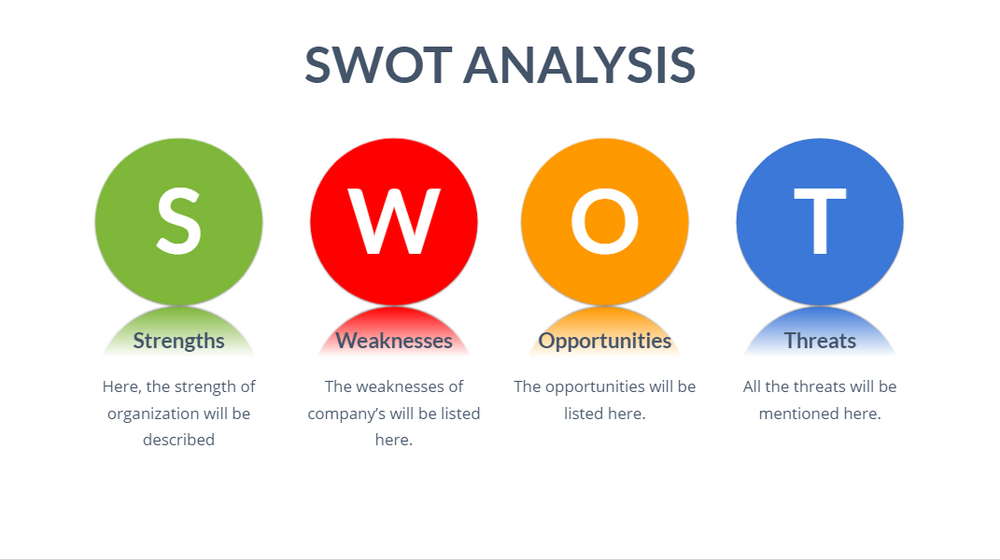
Click here to get this SWOT Template in Google Slides
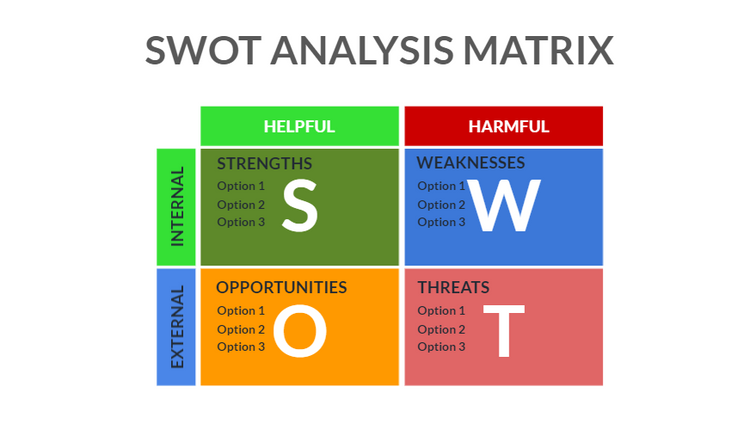
Click here to get the SWOT Matrix Template in Google Slides
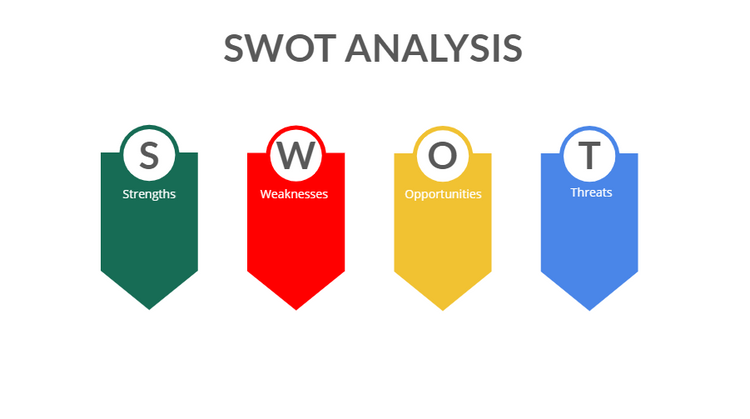
Click here to get this SWOT Analysis Template in Google Slides
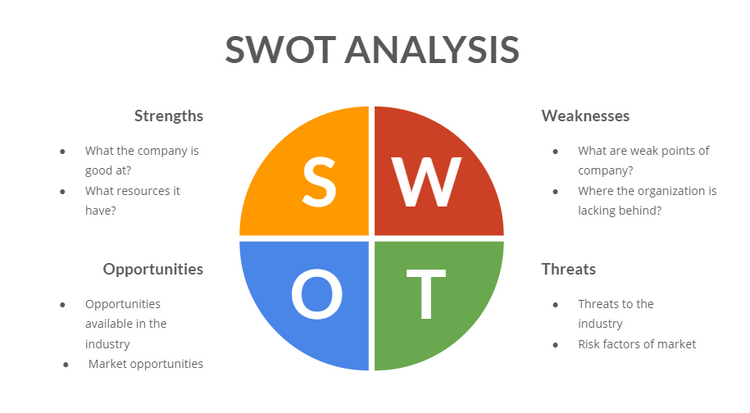
Click here to get this SWOT Analysis Template
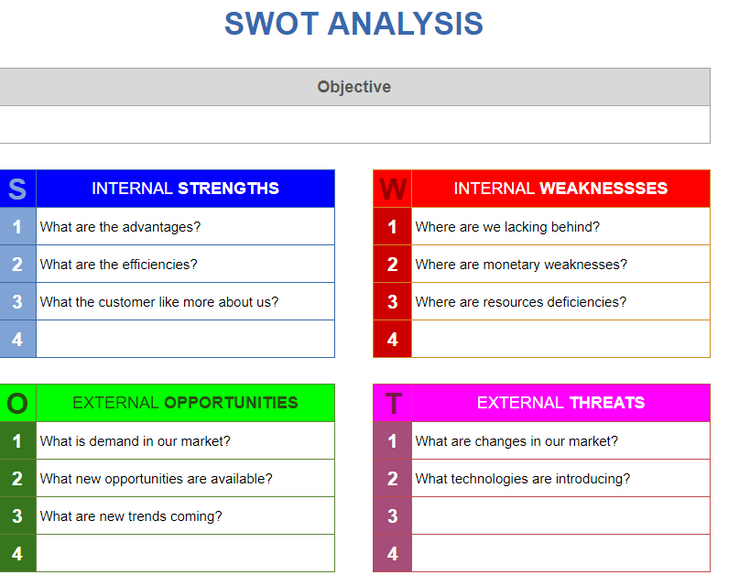
Click here to get this SWOT Analysis Template in Google Sheets
Microsoft Word SWOT Analysis Template
Click here to get Microsoft Word Template for SWOT Analysis
Microsoft Excel SWOT Analysis Template
Click here to get Microsoft Excel Template for SWOT Analysis
PowerPoint Template for SWOT Analysis
Click here to get PowerPoint Template for SWOT Analysis
How Indy can Help
Here at Indy, we aim to help freelancers with the day-to-running of their business. Indy's free SWOT analysis template is a great place to start! We have SWOT templates for every major platform. You can use Word, build a Google Doc, feed data into Excel, or create PowerPoint templates for your business to use!
Here are some other ways Indy can help with your business:
- Our integrated to-do list app makes it simple to keep track of all your tasks. With list and board views, you can see what's coming up and even keep track of your chores from your calendar.
- Independent professionals value their time. With our Calendar app, you can simply book appointments and meetings, track time, and see what's due. It even syncs with your Google Calendar.
With Indy, you can manage all of your business tasks, create contracts, send invoices, and safely store important files all in one place! Sign up today and try for yourself.
Conclusion
A SWOT analysis is the best way for companies to develop and reach short and long-term goals. Whether you're a small startup or a Fortune 500 company, SWOT analysis helps to clarify where you stand with competitors and the best ways to communicate your company's value to customers.
For more information on SWOT analysis', check out our guide How Does a SWOT Analysis Help in a Startup?




